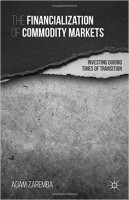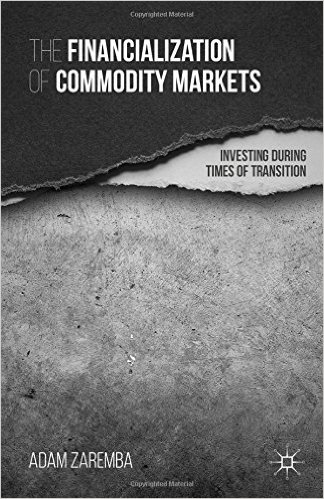 Author: Adam Zaremba
Author: Adam Zaremba
Publisher: Palgrave Macmillan – 249 pages
Book Review by: Sonu Chandiram
You may or may not have heard of the word ‘financialization’ and you may be wondering what exactly it means. It is simply the process by which all tangible and intangible value that is exchanged between people is reduced into a financial instrument.
The intent of financialization is to be able to reduce or transform any work, product, or service into a tradable or exchangeable financial instrument. A simple example of a financialized instrument is a mortgage, by which a worker is trading his or her promise of future work and / or wages in return for a home. Both parties benefit: the borrower gets a home now, and the lender makes a profit over time (or later at one time in the form of a lump sum) on the money lent out, in the form of interest.
If the borrower is an investor, he is purchasing the property to generate additional income, get additional value through appreciation, or acquire an additional asset that hopefully increases his net worth and borrowing ability. For the lender such as a bank for example, the benefits are: to derive additional revenue and profit from the interest earned, and to increase the bank’s overall value from having a larger portfolio of income-producing loans.
Another example of a financialized instrument is a bond, which is essentially a promissory note. When an investor buys a U.S. Treasury bill, bond, or note for example, his benefit is that he earns new money in the future over a time period or in one shot. The benefit of the other party to the contract – the Federal government – is that it is getting money now that it can deficit-spend immediately or over time.
A futures contract involving a commodity is another example of a financialized instrument. In the decade of the 2000s we have seen a tremendous boom in the commodity markets, following the Great Commodities Depression of the 1980s and 1990s, according to Wikipedia.
The prices of essential commodities like agricultural crops, chemicals, metals, and other categories of goods went up between 2000 and 2009, but since then have come down. However the volume of trading (on both buying and selling) has risen significantly.
The author Adam Zaremba cites data from the Bank of International Settlements that show that the number of open items in commodity-related futures contracts climbed eight times from slightly under 20 million in 1993 to a whopping 160 million in 2010. In terms of completed futures transactions, the number soared 15 times, from 40 million to around 600 million in that time period. This is partly attributable to the development of informational and analytical tools on commodities trading.
As the trading volume of commodities has risen greatly, their prices have plunged. An August 15, 2015 news story in the London Telegraph carries the headline Commodity Prices Collapse to Lowest in 12 Years. It mentions that the Bloomberg Commodity Index, which tracks global prices of 22 different commodities, has fallen to the lowest level since August 2002.
This book essentially does three things. It:
- Explores the fundamentals of passive and active investment strategies in commodity markets, discusses sources of return, benchmarks, and performance.
- Investigates the structural changes in commodity markets which took place in during the last decade (2000 to 2010) and their impact on expected returns, risk, or correlations with other asset classes.
- Examines the importance of financialization for commodity investors.
It does the above thru discussions as well as a large number of illustrations. The author uses 135 graphics (90 figures and 45 tables) to support and explain the points he makes in the text portion of this rather unusual, even unique book. The book is simply divided into six chapters plus and Introduction and Conclusion, as shown below.
Introduction
- Asset Allocation in Commodity Markets
- Passive Investment Strategies in Commodity Markets
- Active Investment Strategies in Commodity Markets
- Financialization of Commodity Markets
- Performance Measurement of Commodity Investments
- Commodity Investments in Financialized Markets – A Study
Conclusions
This is a well-researched, superbly informative, and highly analytical book on commodities. It is good for investors and researchers alike.
Author:
Adam Zaremba is Assistant Professor at the Poznan University of Economics in Poznan, Poland. An economist and adviser for investment management companies in Central and Eastern Europe, he has written numerous research papers on financial markets and is also an individual investor with many years’ experience.







